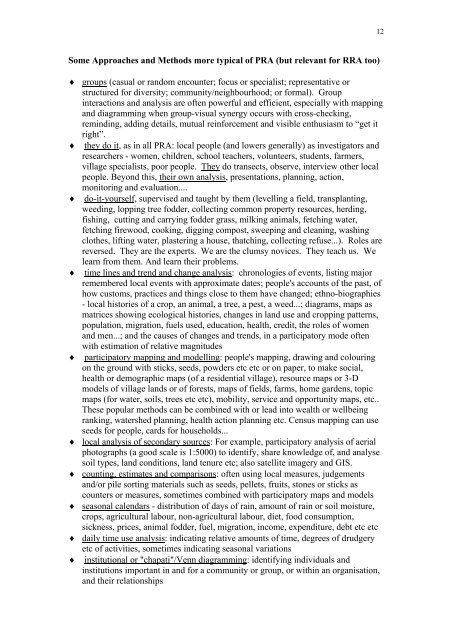R Chambers - Notes for participants in PRA-PLA course.pdf - PACA
R Chambers - Notes for participants in PRA-PLA course.pdf - PACA
R Chambers - Notes for participants in PRA-PLA course.pdf - PACA
You also want an ePaper? Increase the reach of your titles
YUMPU automatically turns print PDFs into web optimized ePapers that Google loves.
12<br />
Some Approaches and Methods more typical of <strong>PRA</strong> (but relevant <strong>for</strong> RRA too)<br />
♦ groups (casual or random encounter; focus or specialist; representative or<br />
structured <strong>for</strong> diversity; community/neighbourhood; or <strong>for</strong>mal). Group<br />
<strong>in</strong>teractions and analysis are often powerful and efficient, especially with mapp<strong>in</strong>g<br />
and diagramm<strong>in</strong>g when group-visual synergy occurs with cross-check<strong>in</strong>g,<br />
rem<strong>in</strong>d<strong>in</strong>g, add<strong>in</strong>g details, mutual re<strong>in</strong><strong>for</strong>cement and visible enthusiasm to “get it<br />
right”.<br />
♦ they do it, as <strong>in</strong> all <strong>PRA</strong>: local people (and lowers generally) as <strong>in</strong>vestigators and<br />
researchers - women, children, school teachers, volunteers, students, farmers,<br />
village specialists, poor people. They do transects, observe, <strong>in</strong>terview other local<br />
people. Beyond this, their own analysis, presentations, plann<strong>in</strong>g, action,<br />
monitor<strong>in</strong>g and evaluation....<br />
♦ do-it-yourself, supervised and taught by them (levell<strong>in</strong>g a field, transplant<strong>in</strong>g,<br />
weed<strong>in</strong>g, lopp<strong>in</strong>g tree fodder, collect<strong>in</strong>g common property resources, herd<strong>in</strong>g,<br />
fish<strong>in</strong>g, cutt<strong>in</strong>g and carry<strong>in</strong>g fodder grass, milk<strong>in</strong>g animals, fetch<strong>in</strong>g water,<br />
fetch<strong>in</strong>g firewood, cook<strong>in</strong>g, digg<strong>in</strong>g compost, sweep<strong>in</strong>g and clean<strong>in</strong>g, wash<strong>in</strong>g<br />
clothes, lift<strong>in</strong>g water, plaster<strong>in</strong>g a house, thatch<strong>in</strong>g, collect<strong>in</strong>g refuse...). Roles are<br />
reversed. They are the experts. We are the clumsy novices. They teach us. We<br />
learn from them. And learn their problems.<br />
♦ time l<strong>in</strong>es and trend and change analysis: chronologies of events, list<strong>in</strong>g major<br />
remembered local events with approximate dates; people's accounts of the past, of<br />
how customs, practices and th<strong>in</strong>gs close to them have changed; ethno-biographies<br />
- local histories of a crop, an animal, a tree, a pest, a weed...; diagrams, maps as<br />
matrices show<strong>in</strong>g ecological histories, changes <strong>in</strong> land use and cropp<strong>in</strong>g patterns,<br />
population, migration, fuels used, education, health, credit, the roles of women<br />
and men...; and the causes of changes and trends, <strong>in</strong> a participatory mode often<br />
with estimation of relative magnitudes<br />
♦ participatory mapp<strong>in</strong>g and modell<strong>in</strong>g: people's mapp<strong>in</strong>g, draw<strong>in</strong>g and colour<strong>in</strong>g<br />
on the ground with sticks, seeds, powders etc etc or on paper, to make social,<br />
health or demographic maps (of a residential village), resource maps or 3-D<br />
models of village lands or of <strong>for</strong>ests, maps of fields, farms, home gardens, topic<br />
maps (<strong>for</strong> water, soils, trees etc etc), mobility, service and opportunity maps, etc..<br />
These popular methods can be comb<strong>in</strong>ed with or lead <strong>in</strong>to wealth or wellbe<strong>in</strong>g<br />
rank<strong>in</strong>g, watershed plann<strong>in</strong>g, health action plann<strong>in</strong>g etc. Census mapp<strong>in</strong>g can use<br />
seeds <strong>for</strong> people, cards <strong>for</strong> households...<br />
♦ local analysis of secondary sources: For example, participatory analysis of aerial<br />
photographs (a good scale is 1:5000) to identify, share knowledge of, and analyse<br />
soil types, land conditions, land tenure etc; also satellite imagery and GIS.<br />
♦ count<strong>in</strong>g, estimates and comparisons: often us<strong>in</strong>g local measures, judgements<br />
and/or pile sort<strong>in</strong>g materials such as seeds, pellets, fruits, stones or sticks as<br />
counters or measures, sometimes comb<strong>in</strong>ed with participatory maps and models<br />
♦ seasonal calendars - distribution of days of ra<strong>in</strong>, amount of ra<strong>in</strong> or soil moisture,<br />
crops, agricultural labour, non-agricultural labour, diet, food consumption,<br />
sickness, prices, animal fodder, fuel, migration, <strong>in</strong>come, expenditure, debt etc etc<br />
♦ daily time use analysis: <strong>in</strong>dicat<strong>in</strong>g relative amounts of time, degrees of drudgery<br />
etc of activities, sometimes <strong>in</strong>dicat<strong>in</strong>g seasonal variations<br />
♦ <strong>in</strong>stitutional or "chapati"/Venn diagramm<strong>in</strong>g: identify<strong>in</strong>g <strong>in</strong>dividuals and<br />
<strong>in</strong>stitutions important <strong>in</strong> and <strong>for</strong> a community or group, or with<strong>in</strong> an organisation,<br />
and their relationships














